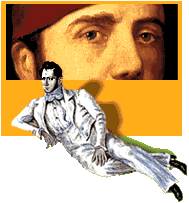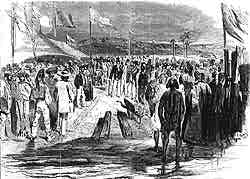 |
Extract from Monde Illustré, n°111, mai 1859
What limits can now be set to man’s power? Water and fire have
given him boundless capabilities. Mankind’s thought flies to the
ground faster than lightning, where it outstrips the winds in
speed. Distance is no more. Great chasms have been dug into the
flanks of the earth, water has flowed in, bringing with it fruitfulness.
The desert is no more. No more do the ages hold secrets for mankind.
Man has penetrated the granite and limestone which was laid down
centuries before man every wlked the planet.
Man here disposes of the mass of the earth as if he were the owner,
changing his house to suit his interests, his ease, his taste.
Isthmuses are cut, seas are joined and continents separated rather
in the way that fences are moved or walls are knocked down.
It was on 25 April that the ceremony reproduced in our engraving
took place. M. de Lesseps work left the world of speculation and
theory to become reality. The commission from the Compagnie universelle
du canal de Suez, with M. de Lesseps as its president, camped
for five days between Lake Menzaleh and the Mediterranean, on
the tip of a beach where the maritime canal is to enter the isthmus.
The marking posts placed in the sand on this side of the desert
where Port-Saïd will have its jetties and its harbours show where
the work will begin.
The Company commission Mssrs Mongel-bey, chief engineer for
Egyptian bridges and roads, director of the work, De Mountant
and Laroche, engineers of bridges and roads, Larvasse, hydrographical
engineer for the navy, Aubert chief doctor, Hardon, site manager
and 150 other employees arrived at 7 o’clock in the morning.
The local fellahs were already there.
After having unfurled an Egyptian flag over the site, M. de Lesseps
took the pickaxe handed to him by the site manager and addressed
those assembled as follows:
![]() «In the name of the Compagnie universelle du canal de Suez and by
virtue of the decisions taken by that company´s board of directors,
I shall strike the first blow opening the East up to the commerce
and the civilisation of the West. We are all here today with the
same feeling of dedication to the interests of the Company and
those of its august creator and benefactor, the Prince Mohammed-Said.»
«In the name of the Compagnie universelle du canal de Suez and by
virtue of the decisions taken by that company´s board of directors,
I shall strike the first blow opening the East up to the commerce
and the civilisation of the West. We are all here today with the
same feeling of dedication to the interests of the Company and
those of its august creator and benefactor, the Prince Mohammed-Said.»
«The exploration which we have just undertaken gives the certainty
that the enterprise which we are beginning here today will not
only be a work of progress but will also bring great profit to
those who build it.»
And amidst scenes of great jubilation, M. de Lesseps, then the members of the commission and the engineers, began to dig the trench for the canal.
«Each of you» said M. de Lesseps later to the Egyptian workmen grouped
around him, «will give your first blow, just as we have just done.
Remember that you are not mere shifting earth, you are bringing
prosperity to both your families and to this beautiful land!»
«Honour to Effendi Mohammed-Said Pasha! Long life to him!»
The digging of the Suez Canal had begun.
It was this imposing scene which our engraving reproduces in its
grandeur and its simplicity.
There in the desert, human civilisation has begun one of its most
remarkable miracles the nomads of these sandy wastes, with their
tales of oases and tents, seem to themselves to be present at
the fulfillment of the dreams. The arab tribes of this part of
the desert shown in our engraving crouching down in wonder on
the platform of the Alexandria station in Suez to see the iron
horses thunder through seem to be no less in enthusiatic about
the announcement of the changes which the canal will bring about.
«As the old men often say The spirit of Allah, which left into the West, has returned.»
Fulgence Gigard.
 |
